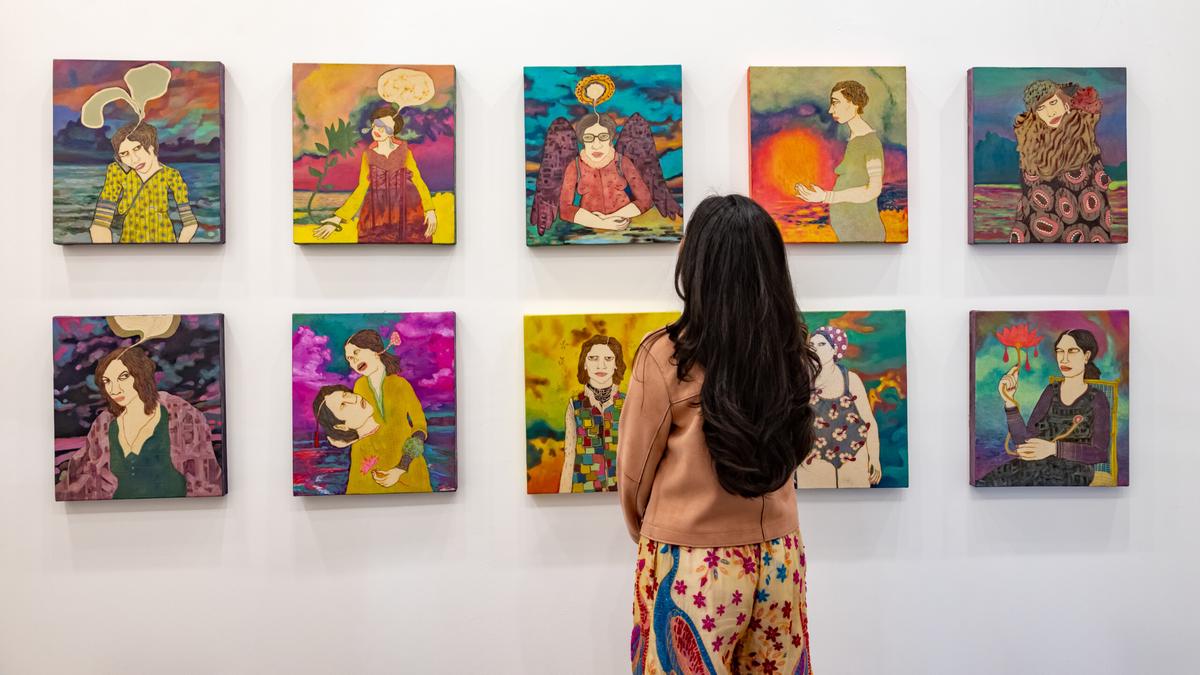
Who is the Indian art collector?
The Hindu
From collectible design and experimental practices to prioritising emotional value, the 2025 India Art Fair saw buying trends evolving, and a buyer profile that is as diverse as it has ever been
Within six hours of day one at the India Art Fair, curator Alaiia Gujral has sold 10 pieces of the collectible design showcase ‘Shifting Horizons’. In the dimly-lit, sparsely-decorated booth, she has brought together pieces by 17 emerging designers, including a fibre-board, teakwood and brass swing, natural dyed rattan and white ashwood stools, and a ceramics-based “illuminating sculpture”.
“Hopefully, a few more will go,” Gujral says with a little laugh, perched on designers Nitush and Aroosh’s Vidya Vrtta, a light installation made of stainless steel, faux fur and glass, taking a breather from answering questions from patrons, many curious about what furniture is doing at an art fair. “Art and design are always in conversation. I’ve been insistent on showcasing new designers and never-seen-before works by prominent ones. It’s affordable and we have a good range. It’s nice that you can own something different in your home.”
Elsewhere in the conjoined tents at Delhi’s NSIC Grounds — whose facade is struck through with artist Ayesha Singh’s minimal, monochrome artwork Skewed Histories and Site Lines — DAG’s multicoloured walls stand out against a sea of white, its booth abuzz with visitors. On display is a show titled ‘DAG Past and Present: 18th-21st century Modern Art’, in which Bengal wash style watercolours, mountain landscapes, Anglo-Indian art as well as Progressives and other modernists vie for attention. “It seems everyone wants to be at the art fair this year,” exclaims Ashish Anand, director of DAG. “The Indian art world has grown in volume and its discernment. Viewers, and collectors are now hungry for more discoveries.”
In a third tent across the green carpeted path lined with makeshift cafes, a stage and outdoor art exhibits, hoards trip over themselves to giggle at the captions accompanying the textile-based works of Viraj Khanna and take selfies with the artist, who is also showing a new set of khakha-based portrait-like acrylic on paper paintings at his show Love Me, Love My Dog at Kalakriti Gallery. “There’s a young collector base that’s interested in buying my work,” observes the medium-agnostic artist. “A lot of people who travel and are seeing a lot of textile in international fairs — they are picking it up. Most of them are from Mumbai, I don’t know why. There’s also people who’ve worn our clothing [his mother Anamika Khanna’s designs] and they want to see what’s happening next.”
For one weekend this month, a corner of New Delhi transforms into its own garden of earthly delights at the 16th edition of the annual India Art Fair (IAF), where art in all manner of shape, form, material, provenance, and pedigree takes centrestage. At its largest edition yet, 120 Indian and international exhibitors show classical, modern and contemporary art — by the superstars, the usual suspects and emerging artists from around the world.
It also spills out into a larger-than-usual radius — where art stands in conjunction with fashion (Kunel Gaur x Almost Gods at Dhan Mill Compound), celebrity (at Shalini Passi’s official IAF party), food (The Kindness Meal at Neem ki Haveli in old Delhi), music (Parvathy Baul responding to Jayasri Burman’s paintings at Art Alive gallery) and, of course, more art (lunches, talks and retrospectives at galleries such as KNMA, Bikaner House and Vadehra Gallery).
The curatorial team’s canvas too has grown wider by the year, with technology, traditional craftsmanship, and sustainable materials being deployed to world and time-melding effect. The results turn up in immersive art installations such as Goa-based artists NON-LINEAR and CURSORAMA’s Biolume, the winning commission for the BMW x India Art Fair ‘The Future Is Born of Art’ project; and outdoor installations like Mumbai-based Yogesh Barve’s I Am Not Your Dalit, supported by Art & Charlie who make their IAF debut this year, in which LED tickers such as those found at railway stations suspended from a glass ceiling broadcast Ambedkar’s message.

In a study published in the journal Mammalian Biology on December 23, 2024, researchers compared the calls of Asian elephants based on their age, sex, and behaviour. They found the duration of trumpets remained fairly consistent across all age classes for both male and female Asian elephants but roars and roar-rumbles got longer with age.












